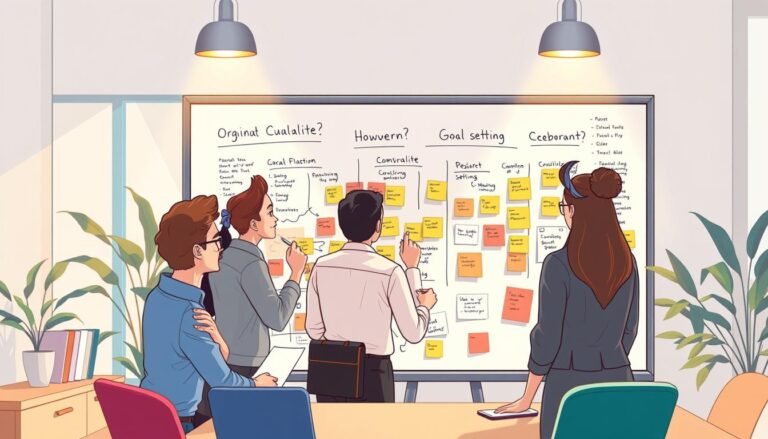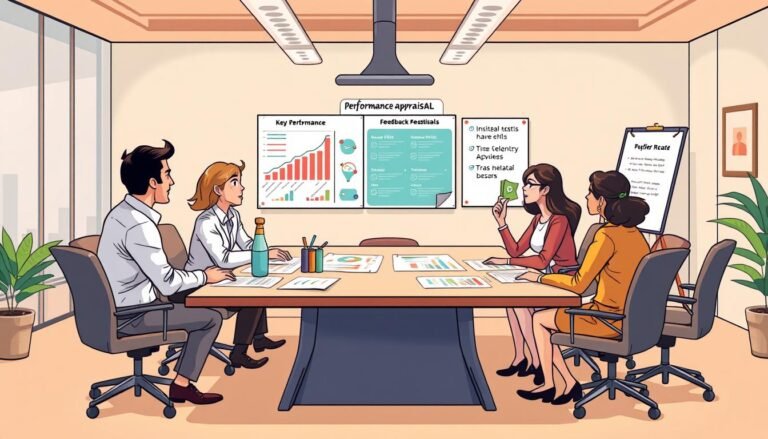Motivation Techniques That Work: Psychological Strategies for Organizational Success
Ever wondered why some companies do well while others struggle? It’s all about motivation. In today’s fast-paced business world, those who know how to motivate their teams stand out. This article explores the best ways to boost success and keep employees happy.
The pandemic changed how we work. Now, flexibility is key to keeping and attracting top talent. Companies that adjust to these new needs are more likely to thrive.
Trust is essential for motivation. Research shows that places with high trust see amazing results. Workers in these environments are less stressed, more productive, and full of energy.
Empathy is a must for leaders, especially now. Leaders who show empathy can really motivate their teams. This creates a positive work culture that leads to success.
Key Takeaways
- Workplace flexibility is crucial for employee retention and attraction
- High-trust environments significantly boost productivity and well-being
- Empathy is a vital leadership skill for motivating employees
- Effective communication enhances trust and employee motivation
- A culture of feedback fosters improvement and productivity
- Active listening and delegation are powerful motivation tools
- Consistency and adaptability in leadership drive employee confidence
Understanding Motivation in the Workplace
Motivation is key to making work productive. It drives how well employees do their jobs and how engaged they are. Let’s look at the different types of motivation and how they help or hinder success.
Intrinsic vs. Extrinsic Motivation
Intrinsic motivation comes from inside, driven by personal interest and fun. Extrinsic motivation, however, comes from outside rewards or penalties. A study by White R.W. in 1959 showed that feeling competent at work is linked to motivation.
The Impact of Motivation on Productivity
Motivation greatly affects how productive a workplace is. Research by Grant A.M. in 2008 found that internal motivation boosts good behavior. This shows why creating a positive work atmosphere is crucial for employee motivation.
Key Factors Influencing Employee Motivation
Many things can motivate or demotivate employees. A 1999 study by Kovach found that “interesting work” is most important to employees, not just good pay. Non-monetary rewards like recognition and health benefits are also powerful and cheap to offer.
- Meaningful work
- Recognition and appreciation
- Growth opportunities
- Positive work environment
- Effective leadership
Knowing these factors helps companies create better motivation plans. Managers should tailor their approach to each employee’s needs. This might include mentoring or flexible work hours.
The Psychology Behind Effective Motivation
Understanding motivation is key for success in any organization. Psychological theories and cognitive motivation shape how employees behave and work. Let’s look at important concepts in motivation psychology and behavioral science that boost workplace performance.
Motivation drives us towards our goals. It has two parts: direction and energy. What motivates us includes our body’s state, our environment, and past experiences. We must process and learn from these factors for motivation to work.
Many theories explain why people are motivated at work. Maslow’s hierarchy says we’re driven by higher needs as lower ones are met. Alderfer’s ERG theory shows how our needs change as we get them. McClelland’s achievement theory groups motives into achievement, affiliation, and power.
“Designing intrinsically motivating activities enhances the learning process by making them sufficiently challenging yet interesting, offering personal control, recognition, and praise for efforts.”
Behavioral science research offers valuable insights. For example, rewarding fun activities too much can lower motivation, known as the overjustification effect. Praising effort more than ability helps us grow and stay motivated over time.
| Motivation Type | Description | Impact on Behavior |
|---|---|---|
| External | Driven by external rewards or punishments | Short-term compliance, may decrease intrinsic motivation |
| Introjected | Based on internal pressures and guilt | Leads to anxiety and stress, unsustainable long-term |
| Identified | Aligned with personal values and goals | Increases engagement and satisfaction |
| Intrinsic | Derived from inherent enjoyment of the task | Leads to highest levels of creativity and performance |
By using these theories and research, companies can better inspire and engage their teams. This leads to better performance and happiness at work.
Motivation Techniques That Drive Organizational Success
Effective motivation techniques are key to boosting employee performance and success. By using the right strategies, companies can create a great work environment. This environment inspires and engages their team.
Setting Clear Goals and Expectations
Goal setting is a powerful tool for motivating employees. Studies show that those involved in goal-setting are 3.6 times more likely to be engaged. SMART goals help set measurable targets that match the company’s goals. This gives employees a clear direction and purpose.
Providing Regular Feedback and Recognition
Regular feedback is crucial for keeping employees motivated. Performance evaluations and quick feedback loops help improve continuously. When employees feel their hard work is recognized, 69% say they would work even harder.
Fostering a Positive Work Environment
A positive work culture is vital for employee motivation. Simple changes like adding plants and using soft colors can boost productivity. Encouraging positivity and allowing short breaks can also reduce stress, which affects 42% of employees’ daily work.
Offering Growth and Development Opportunities
Career development is important to keep employees happy. With 42% of employees feeling their skills are not used enough, offering chances for growth is key. This can greatly increase their motivation and commitment to the company.
| Motivation Technique | Impact |
|---|---|
| Goal Setting | 3.6x increased engagement |
| Recognition | 69% increased effort |
| Positive Work Environment | Reduced stress, higher productivity |
| Growth Opportunities | Increased intrinsic motivation |
Implementing a Growth Mindset Culture
A growth mindset culture in organizations sees challenges as chances to learn. This idea, by Carol Dweck, helps people be resilient and adaptable. Her 2006 book, “Mindset: The New Psychology of Success,” made it popular in business.
Organizations can grow a growth mindset by offering chances for employee development. This change in culture boosts innovation and problem-solving. People who learn about developing their intelligence do better and stay motivated.
- Praising effort over outcomes
- Normalizing struggle as part of the learning process
- Setting incremental goals to demonstrate progress
- Viewing mistakes as learning opportunities
This mindset makes a learning organization where employees are ready for new challenges. For example, Stephen King’s “Carrie” was rejected 30 times before it was published. This shows the strength of persistence in a growth mindset.
| Fixed Mindset | Growth Mindset |
|---|---|
| Focus on proving oneself | Focus on learning and improving |
| View failure as a limit | See failure as an opportunity |
| Avoid challenges | Embrace challenges |
| Give up easily | Persist in the face of setbacks |
By promoting a growth mindset culture, organizations can make a place where employees want to learn, adapt, and do well in their jobs.
The Role of Leadership in Employee Motivation
Leaders are key in motivating employees. They can inspire and empower teams to reach great heights with transformational leadership.
Transformational Leadership Approaches
Transformational leadership is about sharing a vision and supporting each team member. It encourages teams to go beyond their limits and creates a culture of innovation.
Building Trust and Empathy
Building trust is crucial for a safe work environment. High-trust companies see less stress, more energy, and higher productivity. Empathetic leaders make employees feel valued, boosting their motivation and engagement.
Effective Communication Strategies
Good communication is vital for connecting with team members. Leaders should listen actively, be transparent, and check in regularly. Praising employees for their efforts can also lift morale and motivation.
| Leadership Approach | Impact on Employee Motivation |
|---|---|
| Transformational Leadership | Inspires innovation and exceeding expectations |
| Trust-Building | Reduces stress, increases energy and productivity |
| Empathetic Leadership | Enhances employee engagement and satisfaction |
| Effective Communication | Fosters open dialogue and boosts morale |
Using these leadership strategies can motivate a workforce. This leads to success and remarkable achievements.
Leveraging Organizational Justice for Motivation
Organizational justice is key to motivating employees and creating a positive work place. When people feel their workplace is fair, they feel valued and engaged. This fairness boosts productivity and job satisfaction.
Fairness has three main parts: distributive, procedural, and interactional justice. Distributive justice is about fair sharing of resources and rewards. Procedural justice means fair decision-making processes. Interactional justice is about how employees are treated during these processes.
To use organizational justice well, companies should:
- Use clear and open communication
- Have clear, fair policies
- Give fair chances and rewards
- Keep decision-making fair and consistent
Moorman’s (1991) study shows a strong link between fairness and employee effort. When treated fairly, employees are more likely to do extra work. This helps the company succeed.
“Fair treatment fosters trust and commitment among teams, leading to increased motivation and productivity.”
By focusing on fairness and equity, companies can make a place where employees are respected. This approach motivates employees and helps keep the best talent. It also builds a strong, united team.
Overcoming Common Motivation Challenges
Keeping employees motivated is key for success. But, issues like hedonic adaptation, emotional contagion, and burnout can make it tough. Let’s look at ways to beat these challenges and keep a motivated team.
Addressing the Hedonic Treadmill Effect
Hedonic adaptation happens when employees get used to good changes and feel the same again. To fight this, companies can offer ongoing learning and set goals that grow. Using the SMART framework for goals keeps motivation up.
Managing Emotional Contagion in Teams
Emotional contagion makes emotions spread in a group, affecting team spirit. Leaders can use emotional smarts to set a good example and improve team work. Building supportive team bonds and celebrating small victories helps keep the mood high.
Preventing Burnout and Maintaining Engagement
Burnout is a big problem that can stop teams from staying engaged. To avoid burnout, companies should:
- Manage workloads well
- Support work-life balance
- Give the right tools for the job
- Encourage breaks, like the Pomodoro Technique
- Focus on self-care
By tackling these common issues, businesses can build a lasting motivated team. Remember, keeping motivation up is an ongoing effort that needs constant care and change.
Tailoring Motivation Strategies to Different Employee Types
Effective motivation in the workplace isn’t one-size-fits-all. It’s important to recognize individual differences and employee personality types. This boosts productivity and job satisfaction. Personalized motivation strategies can significantly impact team performance and overall success.
A motivation assessment can help identify what drives each team member. Some employees thrive on career advancement opportunities. Others value work-life balance or creative freedom. By understanding these unique preferences, leaders can tailor their approach to motivation. This creates a more engaged workforce.
Research shows that organizations implementing personalized motivation strategies see remarkable results:
- 70% of employees say their purpose is defined at work
- Companies offering mental health support and wellness programs notice a positive impact on employee motivation
- Continuous learning provided through workshops and online courses results in improved skill sets and higher employee motivation
To effectively tailor motivation strategies, consider the following approaches:
| Motivation Strategy | Employee Type | Impact |
|---|---|---|
| Goal-Setting Sessions | Achievement-oriented | Increased motivation and clarity |
| Feedback Loops | Growth-minded | Higher engagement levels |
| Recognition Initiatives | Appreciation-driven | Boosted morale and motivation |
| Work-Life Balance Programs | Balance-seekers | Enhanced job satisfaction |
By implementing these tailored strategies, organizations can create a dynamic and motivated workforce. This workforce drives innovation, productivity, and long-term success.
Measuring the Impact of Motivation Techniques
It’s key to check if motivation strategies work well for a company to succeed. Using data to guide motivation helps improve methods and show their worth. Let’s look at important metrics, tools for checking employee engagement, and how to keep getting better.
Key Performance Indicators for Motivation
Motivation metrics are crucial for knowing how engaged and productive employees are. Important KPIs include:
- Employee retention rates
- Job satisfaction scores
- Productivity levels
- Customer retention rates
Teams that are committed can boost annual turnover by 21%. Companies with strong cultures see a 682% revenue growth over time.
Tools and Methods for Assessing Employee Engagement
Employee engagement surveys are great for checking motivation. They give insights into what motivates staff and what needs work. Other good ways include:
- Regular feedback sessions
- Performance reviews
- One-on-one meetings
Continuous Improvement in Motivation Strategies
To keep motivation high, companies need to keep improving. This means:
- Regularly looking at performance data
- Changing motivation strategies based on what’s learned
- Setting S.M.A.R.T. goals to match employee and company goals
- Creating a culture that values feedback to boost motivation
By focusing on these, companies can make a workplace where most employees feel their performance is managed to motivate them to do great work.
| Motivation Strategy | Impact on Performance | Impact on Retention |
|---|---|---|
| Employee Engagement Initiatives | Up to 44% increase | Up to 66% improvement |
| Clear Goal Setting | 21% revenue growth | Improved alignment |
| Feedback-Rich Culture | Enhanced productivity | Stronger employee satisfaction |
Creating a Sustainable Motivation Framework
Building a sustainable motivation framework is crucial for long-term success. It combines different techniques to meet changing employee needs. This creates a complete motivation system.
A strong framework uses both internal and external motivators. It matches with the company’s values and goals. It includes career paths, recognition, and flexible work options. This boosts productivity and happiness.
Research highlights the importance of motivation:
- Satisfied employees work up to 12% better.
- Only a third of workers feel engaged, showing the need for good motivation.
- Companies with happy staff see a big drop in absences.
To make a lasting motivation framework, focus on these:
- Regular feedback and recognition
- Opportunities for growth
- Clear goals
- A positive work place
- Wellness programs
By focusing on these, companies can build a strong motivation system. This system supports long-term success and resilience. It adapts to each person’s needs, keeping teams engaged.
Conclusion
Learning the best ways to motivate employees is crucial for success in any organization. Organizational psychology gives us important insights into how to motivate people at work. This helps leaders make workplaces where everyone can do their best.
Studies show that recognizing employees can make them 82% happier. Also, clearly telling them what goals to aim for can make them 30% more productive. Investing in training not only makes employees better but also keeps them with the company longer, by 25%.
Not every motivational tactic works the same for everyone. Leaders need to tailor their methods to fit their team’s needs. By focusing on what truly motivates people, giving them freedom, and making them feel valued and part of a team, companies can build a lasting motivation system. This approach is backed by research and can lead to lasting success in today’s fast-changing work world.
Source Links
- 15 Effective Employee Motivation Techniques – PeopleThriver
- The Science of Improving Motivation at Work
- Work Motivation: The Roles of Individual Needs and Social Conditions
- HR017/HR017: Understanding Motivation: An Effective Tool for Managers
- The Behavioral Neuroscience of Motivation: An Overview of Concepts, Measures, and Translational Applications
- What Happens in Our Brains When We Feel Motivated?
- 20 Most Popular Theories of Motivation in Psychology
- 36 Phenomenal Employee Motivation Techniques for 2024!
- How to Improve Employee Performance & Motivation Effectively
- Six Strategies To Maintain Employee Motivation
- How to Foster a Growth Mindset in the Classroom | American University
- The Power of Mindset: 8 Ways to Cultivate a Growth Mindset – Employee and Family Resources
- 5 steps to cultivating a growth mindset culture in your team – Wavestone
- How Leadership Can Contribute To Employee Motivation – PeopleThriver
- The Role of Leadership in Employee Motivation
- 10 Research-Based Industrial / Organizational Psychology Strategies to Boost Motivation and Performance
- Understanding Employee Motivation and Organizational Performance: Arguments for a Set-Theoretic Approach
- Does organizational justice facet matters in knowledge hiding?
- Addressing Common Motivation Challenges and How to Overcome Them
- How to Motivate Yourself: 11 Tips for Self Improvement
- 15 Effective employee motivation techniques to try in 2024 for greater success
- How to motivate employees: 5 strategies for a productive workforce
- Employee Motivation : 20 Easy Ways to Motivate Your Coworkers & Employees
- How to Measure Motivation According to Positive Psychology
- How to Measure and Improve the Motivation Level of Employees?
- How Employee Motivation Impacts Performance – PeopleThriver
- Top 5 motivation theories to use in the workplace
- How to Motivate Employees: 12 Easy Ways to Uplift Workers – eCardWidget
- Motivation Techniques: Growth Mindset: Cultivating Potential: The Growth Mindset as a Motivational Framework – FasterCapital
- Employee Motivation Techniques
- How to Motivate Someone, Including Yourself







